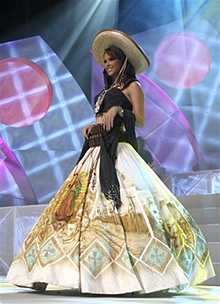 |
 |
 |
 Entertainment | April 2007 Entertainment | April 2007  
Miss Mexico Tones Down Pageant Dress
 Julie Watson - Associated Press Julie Watson - Associated Press


| | Miss Mexico, Rosa Maria Ojeda, poses with a floor-length dress, belted by bullets and accented by sketches of hangings during Mexico's Roman Catholic uprising in the 1920s during a presentation in the city of Tampico, Wednesday, Aug. 30, 2006. The dress has outraged Mexicans who said it was inappropriate for the world's most important beauty contest. (Milenio Diario de Tampico/Julio Nevero) |
Miss Mexico is toning down her Miss Universe pageant dress — not because it's too slinky or low-cut, but because its bullet-studded belt and images of hangings from a 1920s uprising have outraged Mexicans.

The floor-length dress is accented with crosses, scapulars and a sketch of a man facing a firing squad. Designers who helped select the dress from among 30 entries argued it represented the nation's culture and history, especially since Mexico City is hosting the pageant in May.

Cut from a traditional natural cotton called manta, the dress depicts scenes from the 1926-1929 Cristero war, an uprising by Roman Catholic rebels against Mexico's secular government, which was imposing fiercely anti-clerical laws. Tens of thousands of people died.

"We wanted a dress that made you think of Mexico," Hector Terrones, who served on the selection committee, told La Jornada newspaper. "The design should grab people's attention and have impact without giving too much information."

But many Mexicans weren't happy about the history the dress evoked, especially at a moment of debate about the Catholic Church's role in politics and its lobbying against a Mexico City proposal to legalize abortion. Others said it glorified violence in a country where a battle between drug gangs has brought a wave of killings and beheadings.

Miss Mexico, Rosa Maria Ojeda, presented the dress March 29, showing off the billowing, hoop skirt adorned with sketches of Catholic rebels hanging from posts. Rosaries and scapulars hung from the bullet-studded, bandolier belt; a large crucifix necklace, black halter top and wide-brimmed sombrero completed the outfit.

"It's inappropriate to use images of this Cristero war that cost so many lives and was so pointless," said Guadalupe Loaeza, a contemporary Mexican writer.

The gown's designer, Maria del Rayo Macias, told La Jornada that "we are descendants of Cristeros. Whether we like it or not, it's a part of who we are." Macias is from Guadalajara, a city in what was the Cristero heartland.

La Jornada columnist Jorge Camil said a dress was not the place to recount the event.

"It would be like Miss USA wearing a dress showing images of the Ku Klux Klan in the deep South, with their hoods, their burning crosses and beer cans," he wrote. "A beauty contest is very far from being the right place to vent political and religious ideologies."

Ojeda's representatives did not return phone calls seeking comment, but said in a statement the dress would be "modified" due to "the concerns that have surfaced regarding the design." Pageant spokeswoman Esther Swan said the skirt would have ribbons and ruffles and no pattern, while the top would remain the same.

Mexican church officials also argued that using the war as a fashion statement was disrespectful to the thousands who died, some of whom were later named saints.

The conflict was the culmination of a century of bloody struggles over liberal attempts to slash the power of the church, which had been an arm of the Spanish colonial government for three centuries, owning vast tracts of land and savagely persecuting rival religions. The church later supported a foreign invasion of the country.

The secular government that emerged from Mexico's revolution of 1910-1917 toughened anti-clerical laws imposed earlier, setting off a conflict in which churches and convents were shuttered, foreign priests were expelled and mobs sacked sanctuaries. Religious raiders responded by blowing up passenger trains and attacking government forces.

By the time the U.S. Embassy helped mediate an end to the violence in 1929, only a few hundred priests remained in Mexico.

"It's not right for Mexico, in an important international event like Miss Universe, to remember this sad and unfortunate fact of our history," Monsignor Felipe Arizmendi Esquivel told La Jornada. "This traditional outfit alludes to events that opened deep wounds."

On the Net: MissUniverse.com | 
 | |
 |



